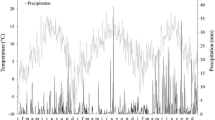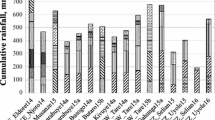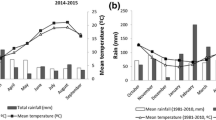Abstract
Wheat (Triticum aestivum L.) fields in the semi-arid Northern Great Plains are spatially variable in soil N fertility and crop productivity. Consequently, there is interest in applying variable, rather than uniform rates of fertilizer N across the landscape. Intensive soil sampling as a basis for variable-rate fertilizer management is too costly when compared to the value of wheat in this region. The objective of this research was to determine relationships between yield and protein, and protein and available N as needed to develop a cost-effective variable-rate N fertilizer strategy for spring wheat. A three-year study (1996–1998) was carried out at a site near Havre, Montana, USA (48°30′N, 109°22′W). Treatments consisted of three water regimes, four cultivars, and five fertilizer N levels per water regime in a randomized complete block design with four replicates. Scatter diagrams of relative yield vs. grain protein were consistent with earlier investigators, and indicated protein concentrations at harvest provided a method for indexing N nutrition adequacy (deficiency vs. sufficiency) in wheat. A critical protein concentration of 13.2% was defined using a graphical Cate-Nelson analysis. This value appeared to be consistent across the three water regimes and four cultivars as 159 (88%) of the 180 water×cultivar×N level episodes were in positive quadrants. No correlation could be found between relative yield and protein for episodes below the critical level (r2=0.1). Hence, grain protein concentrations could not be used to predict the magnitude of yield losses from N deficiency. Grain protein content would be useful for prescribing fertilizer recommendations where N deficiency (<13.2% protein) reduces grain yield under semi-arid conditions. Inverse slopes (dy/dx) of the protein-available N curves reveal that it takes 12–18 kg N/ha to change protein 1% (e.g., 12% vs. 13%) where wheat is under water stress during grain fill. The total N requirement could then be computed by summing the N required for raising protein and the N removed by the crop in the year when the grain was harvested.
Similar content being viewed by others
References
R. B. Cate, Jr. and L. A. Nelson, North Carolina State University International Soil Testing Series Technical Bulletin 1 (1965).
R. E. Engel, D. S. Long, and G. R. Carlson, Better Crops with Plant Food 81(4), 20 (1997).
R. E. Engel, Agronomy Journal 83, 180 (1991).
D. M. Glenn, A. Carey, F. E. Bolton, and M. Vavra, Agronomy Journal 77, 229 (1985).
R. J. Goos, D. G. Westfall, A. E. Ludwick, and J. E. Goris, Soil Science America Journal 74, 1033 (1982).
R. J. Goos, Journal of Agronomic Education 13, 103 (1984).
D. R. Keeney and D. W. Nelson, in Methods of Soil Analysis, Part 2, edited by A. L. Page (American Society of Agronomy, 1982), p. 643.
T. C. Keisling and B. Mullinix, Soil Science Society America Journal 43, 1181 (1979).
W. E. Larson and P. C. Robert, in Soil Management for Sustainability, edited by R. Lal and F. J. Pierce (Soil Water Conservation Society, Ankeny, IA, 1991), p. 103.
D. D. Malo and B. K. Worcester, Agronomy Journal 67, 397 (1975).
M. P. Miller, M. J. Singer, and D. R. Neilsen, Soil Science Society America Journal 52, 1133 (1988).
D. J. Mulla, A. U. Bhatti, M. W. Hammond, and J. A. Benson, Agriculture, Ecosystems, and Environment 38, 301 (1992).
W. H. Pierre, L. Dumenil, V. D. Jolley, J. R. Webb, and W. D. Shrader, Agronomy Journal 69, 215 (1977).
W. H. Pierre, L. Dumenil, and J. Henao, Agronomy Journal 69, 221 (1977).
S. Pocknee, B. C. Boydell, H. M. Green, D. J. Waters, and C. K. Kvien, in Proceedings 3rd Internal Conference on Precision Agriculture, edited by P. C. Robert, R. H. Rust, and W. E. Larson (American Society of Agronomy, Minneapolis, MN, 1996), p. 159.
P. C. Robert, Geoderma 60, 57 (1993).
SAS Institute, SAS/STAT Guide for Personal Computers, Ver. 6 ed. (SAS Institute, Incor., Cary, NC, 1985).
S. W. Searcy, in Proceedings 2nd International Conference on Site-specific Management for Agricultural Systems, edited by P. C. Robert, R. H. Rust, and W. E. Larson (American Society of Agronomy, Minneapolis, MN, 1994), p. 603.
J. V. Stafford, in Proceedings 3rd Int. Conference on Precision Agriculture, edited by P. C. Robert, R. H. Rust, and W. E. Larson (American Society of Agronomy, Minneapolis, MN, 1996), p. 595.
F. Steenbjerg, Plant and Soil 3, 97 (1951).
R. Sweeney, and P. Rexford, Journal Association of Analytical Chemists 70, 1028 (1987).
Author information
Authors and Affiliations
Corresponding author
Rights and permissions
About this article
Cite this article
Engel, R.E., Long, D.S., Carlson, G.R. et al. Method for Precision Nitrogen Management in Spring Wheat: I Fundamental Relationships. Precision Agriculture 1, 327–338 (1999). https://doi.org/10.1023/A:1009929226268
Issue Date:
DOI: https://doi.org/10.1023/A:1009929226268




